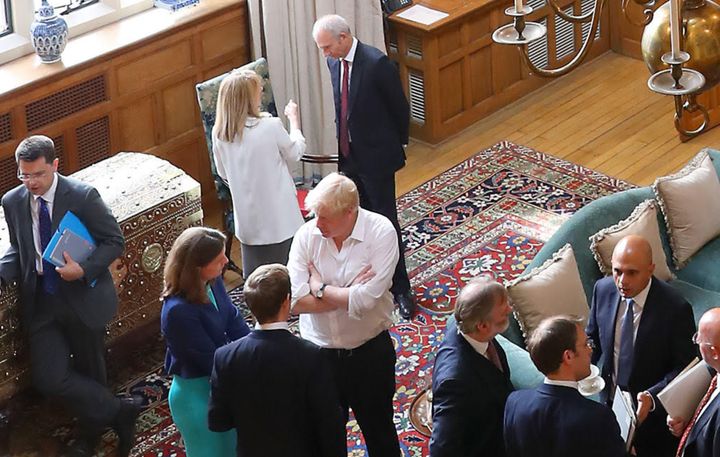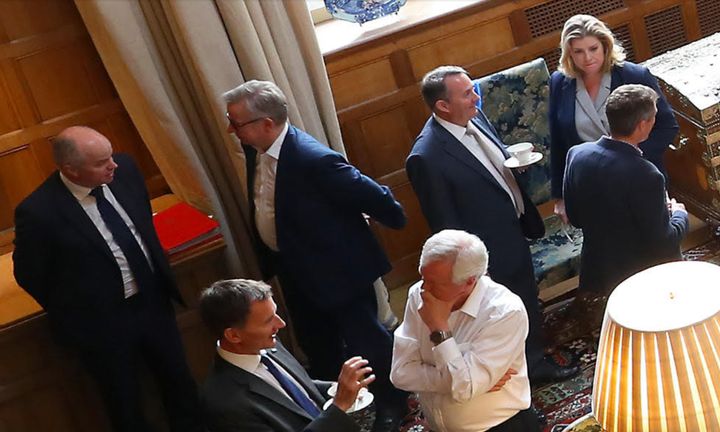Theresa May has faced down a potential Cabinet rebellion over Brexit after her ministers agreed plans for a new UK-EU free trade deal.
Following a marathon meeting at her Chequers country home, the Prime Minister hailed the new plan for a “common rule book” with Brussels to protect jobs and avoid a hard border in Northern Ireland.
In a bid to reassure worried Brexiteers, the compromise proposal for EU customs arrangements gives the British Parliament the final say over any future changes.
Seven Cabinet ministers led by Boris Johnson had met on Thursday to discuss their worries about the proposals, but May appeared to have won them round with an insistence that the UK would still “take back control” of its “money, laws and borders”.
She said that she now wanted “to move at pace” to discuss the plans with the EU, ahead of a crucial summit in October.
A new ‘White Paper’ setting out the detail of the plans will be published next week.
But within minutes of the outlines of the plans being published, former UKIP leader Nigel Farage claimed the Cabinet Brexiteers were “career politicians all”. One group said the agreement represented ‘fake Brexit’.

The UK is due to leave the EU next March but it has taken more than two years since the EU referendum for the Government to finally agree among itself the kind of Brexit it wants.
“Our proposal will create a U.K. - EU free trade area which establishes a common rule book for industrial goods and agricultural products,” May said.
“This maintains high standards in these areas, but we will also ensure that no new changes in the future take place without the approval of our Parliament.
’As a result, we avoid friction in terms of trade, which protects jobs and livelihoods, as well as meeting our commitments in Northern Ireland.
’We have also agreed a new business-friendly customs model with freedom to strike new trade deals around the world.”

The deal was hammered out over a lunch of BBQ chicken and a dinner of Oxfordshire beef fillet, No.10 revealed. Break-out groups also met outdoors during the long, hot day.
Davis is understood to have raised his worries that one compromise - dubbed a ‘facilitated customs arrangement’ - could prove unacceptable to the EU.
But May’s allies insist the plans are the most likely to win both Parliamentary backing and allow talks with Brussels to move on to the next stage.
In an apparent bid to reassure International Trade Secretary Liam Fox, the agreement states the UK could potentially apply to join the Trans-Pacific Partnership which boosts free trade between countries like Australia, Canada, Mexico, Chile and Singapore.
The PM is due to meet her backbench MPs on Monday to sell the package to sceptics.
WHAT’S IN THE DEAL?
Goods harmonisation
A No.10 statement says the UK will “maintain a common rulebook for all goods” including agricultural products after Brexit, allowing continued harmonisation of trade.
The UK Parliament would have the final say but the statement insists that environmental, employment and consumer protection rights would not be downgraded.
Services however would get less mutual access between the UK and EU.
Customs
A ‘facilitated customs arrangement’ would operate under a ‘combined customs territory’. The UK would apply its own tariffs for goods intended for the UK, but EU tariffs for goods (estimated at about 4% of all such trade flows) heading into the EU.
The plan aims to allow Britain to set tariffs with the rest of the world while continuing ‘frictionless’ trade at the border with the EU. It claims that as a result there would be no ‘hard border’ between Northern Ireland and the Irish Republic.
Courts
A “joint institutional framework” would interpret UK-EU agreements, to be carried out in each jurisdiction by the respective courts. But UK courts would have to show “due regard paid to EU case law in areas where the UK continued to apply a common rulebook”.
A new system of joint committees would oversee the rules and be subject to binding independent arbitration in the event of any disputes. Crucially the arbitration would have reference to the European court of justice (ECJ) “as the interpreter of EU rules”.
Farage was withering in his criticism.
Hardline Brexit group Leave Means Leave was also scathing, with its co-chair John Longworth declaring the plans showed “Theresa May’s true colours”.
“This is a bad deal for the UK which will only slide further as the EU take more and more. Our weak Prime Minister has driven the process of leaving the EU inscrutably into a corner, in concert with her Chancellor” he said.
“The Prime Minister has totally misled 17.4 million voters and left it as late as possible to reveal that she remains a stubborn Remainer.
“Worse still, she has personally deceived us by promising in the Conservatives’ election manifesto that Brexit means Brexit when, in fact, May’s Brexit means BRINO – “Brexit In Name Only” – a fake Brexit.”
EU Brexit chief Michel Barnier welcomed the fact that there was more clarity but made clear the workability of the plans needed careful scrutiny.
Shadow Brexit Secretary Keir Starmer said: “It is farcical that it has taken two years for the Cabinet to even attempt to agree a position on the basics of our future relationship with the EU.
“On previous form, whatever has apparently been agreed will struggle to survive contact with Tory MPs and members.
“This looks like a sticking plaster rather than the Government’s final position. With just a matter of months of the negotiations left, Theresa May’s ability to deliver Brexit continues to be in doubt.”
